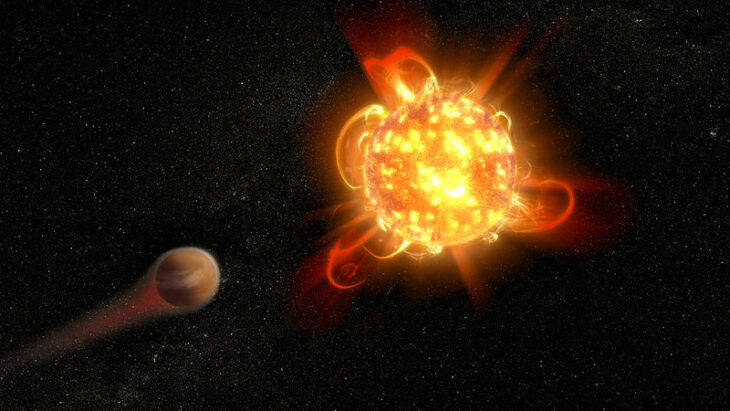Astronomers investigate the possibility of life around other stars primarily by focusing on the distance at which any exoplanets orbit them. If an exoplanet is close enough to the star that all its water isn’t frozen and far enough away that its water isn’t evaporated and stripped away, it is said to be within the habitable zone. While many other factors could determine how likely life is to emerge on a planet, including the presence of a Jupiter-like planet in its system or a large Moon orbiting it, researchers agree that the habitable zone is a baseline necessity.
One team of astronomers investigated one of these other aspects of habitability: the dangers of the stellar neighborhoods around stars with exoplanets in their habitable zone. Most stars are far enough apart that they don’t directly interfere with their neighbors’ planets. But, given time, neighboring stars could cause problems for anything living in stellar systems.
Stars the size of the Sun passing each other at distances within 200 times the distance the Earth orbits the Sun, meaning within 20 billion miles or 30 billion kilometers, could gravitationally pull on each other’s planets. These flybys might drag exoplanets out of their respective habitable zones or fling them out of their star system entirely! At distances up to 200 trillion miles or 300 trillion kilometers, also known as 10 parsecs, stars bigger than 8 times the mass of the Sun die in explosions called supernovae that can bathe neighboring planetary systems in enough X-rays and gamma rays to disrupt atmospheres, destroy ozone layers, and potentially wipe out all living things.
To assess the risk of these events, this team analyzed data from the Gaia Data Release 3 and Hipparcos catalogs that include the 146 known star systems with planets in their habitable zone. Of these 146 star systems, only the 84 closest to the Sun, within 220 parsecs, 4 quadrillion miles, or 7 quadrillion kilometers, have neighboring stars whose distances have been measured to within an uncertainty of 10 parsecs. By focusing on those 84, the team could best assess the real risks of extinction-level events exoplanets face in those systems.
To assess the risk of flybys, they used an equation that estimates the number of passing encounters between stars over time based on the radius of a star system, how many neighboring stars it has per cubic parsec, and how fast the average star in its group moves. They plugged the relevant data for each of the 84 stars into a Python program and found that only 1 star was likely to have a passing encounter with another star within the next 5 billion years. The team explained that this finding supports the prevailing hypothesis that having fewer neighboring stars is better for a system’s chance of supporting life, as this example came from the star with the most neighbors in the whole set.
To assess the risk of supernovae, they identified other stars within 10 parsecs of their 84 star systems and used their brightness and temperatures to calculate their masses. For any given star bigger than 8 times the mass of the Sun, they calculated that its supernova would bathe any planet within this 10-parsec range in 100 billion times the radiation Earth receives from the Sun. They found that only 2 of the 84 star systems they tested had a large neighboring star within 10 parsecs, though they acknowledged that other scientists have suggested that up to 20 parsecs may still be too close to stay unharmed.
Overall, the team concluded that the risk of an extinction-level event caused by a neighboring star faced by known habitable zone planets is low. However, they cautioned that current astronomical catalogs are incomplete, which means their calculations have to be considered low-end estimates of the real risks faced by possible alien life. They suggested that future deep-sky surveys will help improve estimates of risks faced by life in these systems and expand the number of systems on which researchers can perform similar risk analyses.


